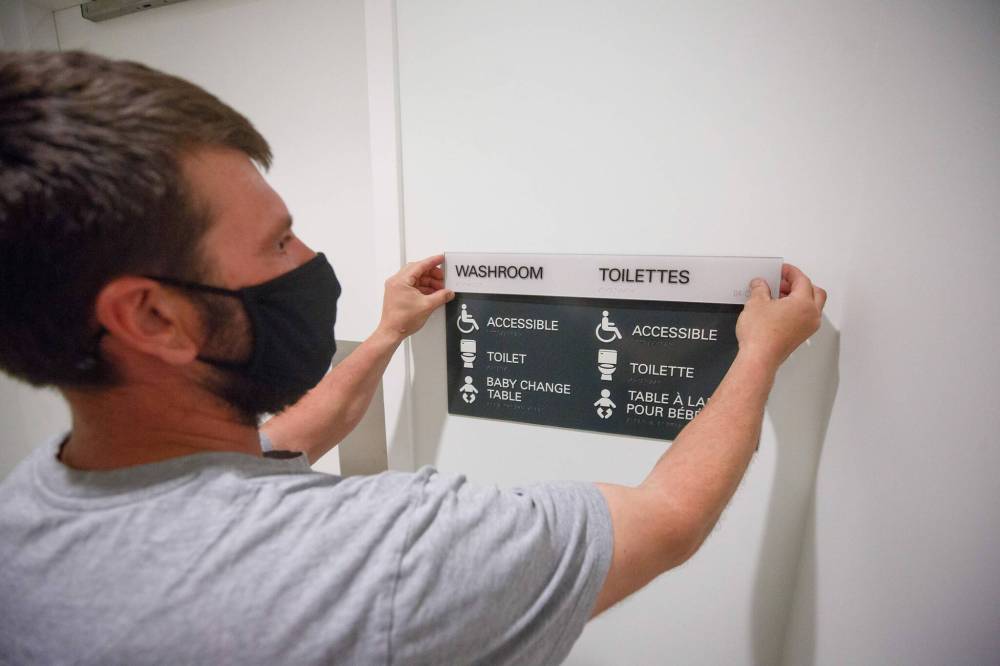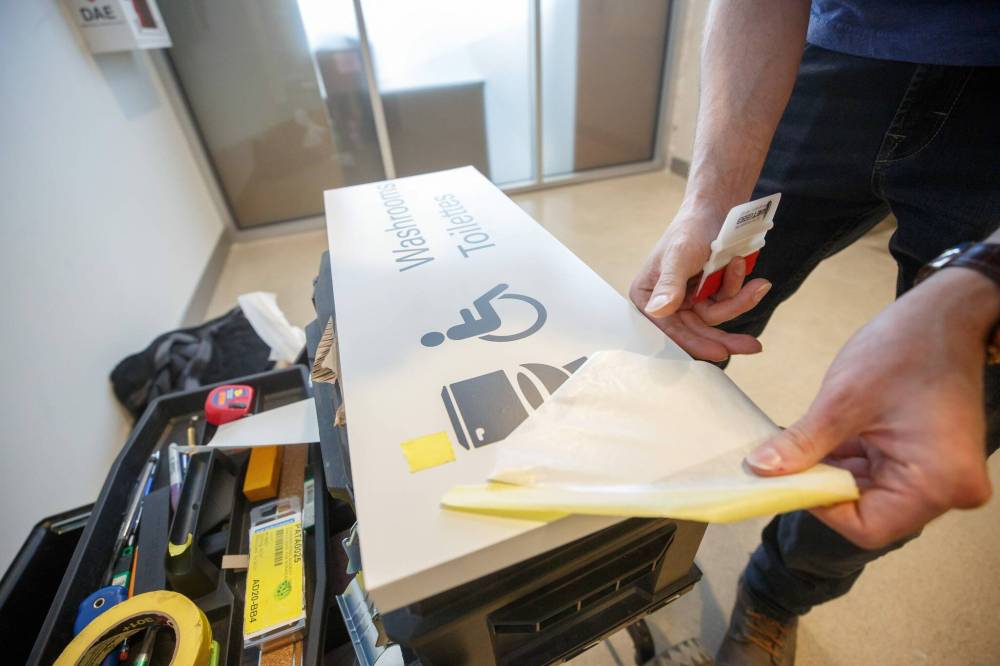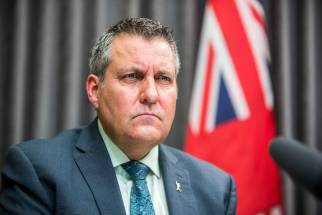Signs of the times Canadian Museum for Human Rights replaces “male” and “female” icons to make public washrooms gender-inclusive spaces
Read this article for free:
or
Already have an account? Log in here »
To continue reading, please subscribe:
Monthly Digital Subscription
$0 for the first 4 weeks*
- Enjoy unlimited reading on winnipegfreepress.com
- Read the E-Edition, our digital replica newspaper
- Access News Break, our award-winning app
- Play interactive puzzles
*No charge for 4 weeks then price increases to the regular rate of $19.00 plus GST every four weeks. Offer available to new and qualified returning subscribers only. Cancel any time.
Monthly Digital Subscription
$4.75/week*
- Enjoy unlimited reading on winnipegfreepress.com
- Read the E-Edition, our digital replica newspaper
- Access News Break, our award-winning app
- Play interactive puzzles
*Billed as $19 plus GST every four weeks. Cancel any time.
To continue reading, please subscribe:
Add Free Press access to your Brandon Sun subscription for only an additional
$1 for the first 4 weeks*
*Your next subscription payment will increase by $1.00 and you will be charged $16.99 plus GST for four weeks. After four weeks, your payment will increase to $23.99 plus GST every four weeks.
Read unlimited articles for free today:
or
Already have an account? Log in here »
Hey there, time traveller!
This article was published 17/05/2022 (1304 days ago), so information in it may no longer be current.
The Canadian Museum for Human Rights is making all its washrooms into inclusive spaces that anyone can use, regardless of their gender identity.
On Monday morning, tradespeople removed the signage with the familiar “male” or “female” icons from each of the Winnipeg institution’s 18 public bathrooms, replacing them with signage depicting icons of the amenities inside — toilets, urinals and change tables. Any staff or volunteer washrooms in the building will also move away from the binary — male or female — gender system. Bathrooms that were already single-occupant areas will remain that way.
Every bathroom will also soon be equipped with dispensers full of free menstrual products and disposal units.
“We want everybody to be able to go to the washroom in safety and comfort,” said Haran Vijayanathan, the museum’s director of equity and growth. “We don’t want to force people to comply with a binary system of gender (to which they may not subscribe).”
While for decades the norm has been to divide bathrooms into male and female categories, gender exists beyond that binary, says Noreen Mian, the executive director of the Rainbow Resource Centre, which offers many forms of support to the local LGBTTQ+ community.
Mian called the museum’s potty progress a “step in the right direction,” affirming individual and collective rights of access to inclusive and safe spaces, while supporting the needs of transgender, non-binary or other gender-diverse people, as well as cisgender (those whose gender corresponds with their birth sex) allies.
“It normalizes the reality that people don’t only identify as male or female,” said Mian, whose organization was consulted by the museum ahead of the change. “It feels like an active demonstration on their part of doing better and addressing the harms of the past.”
Over the last two years, the museum has experienced an identity crisis it has been forced to address head-on. A 2020 review of the institution — spurred on by revelations that some LGBTTQ+ content had been censored or hidden from select tour groups between 2015 and 2017 — declared that the CMHR had a “pervasive” and “systematic” problem with racism, sexual harassment and homophobia, which led to broad public criticism, as well as an administrative upheaval.
The previous CEO, John Young, left the museum in August 2020, and in his stead, the federal minister of heritage appointed human rights lawyer Isha Khan, who became both the first woman and first person of colour to lead the CMHR.

A followup report by Winnipeg lawyer Laurelle Harris released in the fall of 2021 found more equity-related issues affecting members of the LGBTTQ+ community and people of colour. Both reports made several recommendations to move forward.
One such recommendation was to review all communication to identify and remove gender binaries. Another was to review all visitor-facing resources, including name tags and signage, to ensure that they respect gender diversity.
Broadly speaking, there has been significant movement in terms of understanding gender as a non-binary concept in Canada, with much more needed. In 2017, the Canadian Humans Rights Act and the Criminal Code were amended to protect individuals from discrimination and hate crimes based on either gender identity or expression, protections for which the LGBTTQ+ community had advocated for years.
The most recent Canadian census included an option to specify the gender individuals were assigned at birth as well as the gender they identify with today. “This addressed an important information gap on gender diversity,” a Statistics Canada release said. It was the first national census in the world to collect and publish gender diversity data, the organization said.
According to the census, in May 2021, one in 300 people over the age of 15 in Canada identified as transgender or non-binary. The proportions of transgender and non-binary people born between 1997 and 2006 were significantly higher than in previous generations. About one per cent of adults between 20 and 24 identified as transgender or non-binary.

In Manitoba, there were 3,620 identifying as transgender or non-binary, representing roughly 0.34 per cent of the province’s population. Because all the data was based on self-reporting, the proportion could be and likely is higher, as some people are not comfortable sharing that information.
That’s partially because there still remains a stigma against trans and non-binary individuals, who continue to face marginalization, harassment, and often violence owing to their identities, including when using public washrooms, Vijayanathan said. (Wednesday, May 17, is the International Day against Homophobia, Biphobia and Transphobia.)
Mian of the Rainbow Resource Centre said concrete changes to infrastructure and policy reduce that stigma and create opportunities for inclusion and increased comfort. She was impressed that rather than changing one or two bathrooms to become gender-inclusive, the museum did so for each facility in the building. That sort of move helps affirm people’s gender identities, she said, and could lead other organizations to make similar changes.
With the bathroom change, Vijayanathan — whose job was created in response to the concerns of 2020 — says the museum is addressing previous issues and ongoing inclusivity considerations in a simple but crucial way. On the museum’s website, there’s a list of every recommendation that tracks how they’ve been put into action.
“We can proudly say we’ve begun implementing all of them,” he said. “We are not perfect by any means, but we are moving in the right direction.”
The next step in the bathroom department is to work with an architect to make physical changes beyond the signage, including increasing privacy with higher stalls.

But first, the binary washroom signage had to go.
ben.waldman@winnipegfreepress.com

Ben Waldman covers a little bit of everything for the Free Press.
Our newsroom depends on a growing audience of readers to power our journalism. If you are not a paid reader, please consider becoming a subscriber.
Our newsroom depends on its audience of readers to power our journalism. Thank you for your support.







